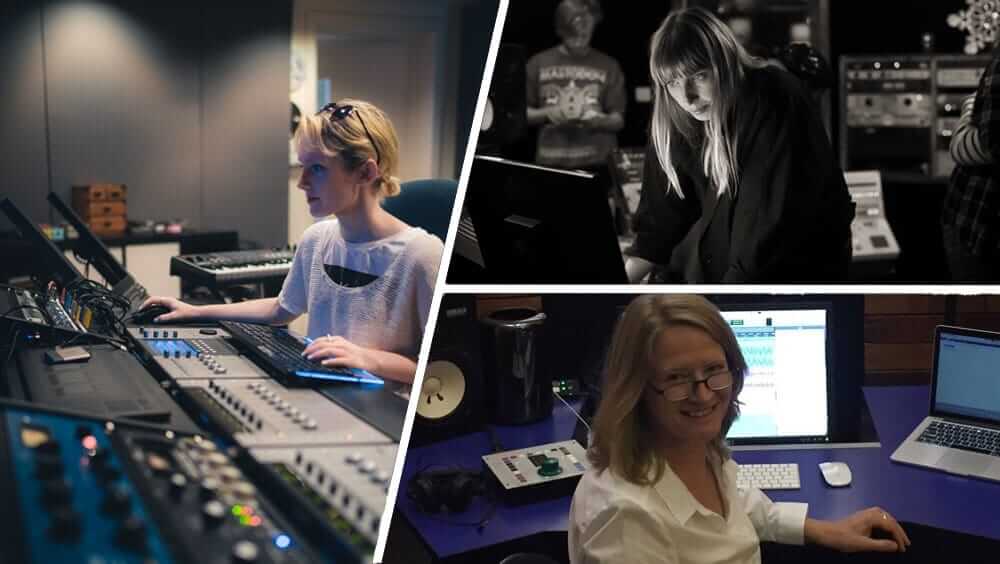
Women like Hendren and Keyes spend many years mastering their craft as per the research. When she’s not teaching at Sound Camp, Hendren is a full-time sound engineer who works for venues in St. Louis and tours with bands. Hendren got her start by spending five years as a monitor engineer, which means she was in charge of what artists hear on stage. Her venue saw 150 to 175 shows a year, but she says she can count on one hand the number of female sound engineers she met during that time.
“The guys who worked at the venue were great,” Hendren says of The Pageant in St. Louis. “But she always felt like she had to be a bit better at her job than they were. And then when she started talking to other women and had that feeling confirmed, it was like, ‘Okay, she was not imagining this. This was really taking her a lot more effort than it’s taking that guy over there.’” Hendren says she has lost work for being a woman; in one case, she was rejected for a job because the band’s wives were uncomfortable with a woman being on the bus.
Teaching at Sound Camp has been life changing for Hendren. When she describes the first time she saw the girls run a show without her help, she tears up. “It was so great,” Hendren says. “It was really amazing to feel like she did something for someone that no one was able to do for her.”
Despite the challenges, women have been producing music for decades. In the 1950s, when Cordell Jackson (nicknamed “the rock-and-roll granny”) couldn’t break into Sun Records, she started her own Memphis-based label, Moon Records, likely making her the first female record producer and engineer in the U.S. Other early women producers include Bonnie Guitar, whose label made hits like The Fleetwoods’s “Come Softly to Me,” and Sylvia Moy, who produced Motown acts and worked with Stevie Wonder. Ellie Greenwich co-wrote and co-produced hits like “Chapel of Love” and “Leader of the Pack.” Sylvia Robinson, known as the ‘’godmother of hip-hop,” started Sugar Hill Records, which put out the seminal track “Rapper’s Delight” in 1979.
Today, prominent female producers include Sylvia Massy, Sally Browder, Leslie Ann Jones, and Kara DioGuardi. There’s the rapper Missy Elliott, who has built a well-regarded career as a producer; Linda Perry from 4 Non Blondes, who has worked with artists like Pink and Christina Aguilera; and Tokimonsta, a classically trained pianist who has worked with Kelly Rowland. Still, younger rising stars include WondaGurl, a Canadian beatmaker who has been producing since she was 9 years old and who famously worked with Jay-Z when she was 16.
The impressive individual accomplishments of these women, however, don’t change the overall systemic picture, the fact that list after list from music publications ranking top producers often don’t include a single woman. Billboard’s 2016 Power 100 list only has 14 women on it, with none in the top 10. No woman has won the Grammy for Producer of the Year (Non-Classical). In the award’s 43-year history, there have been only six women nominees for that category: Janet Jackson,
As the last set of examples suggests, when a woman is lauded for her producing skills, she’s usually also a well-known performer. Men, on the other hand, are more likely to be touted for their musical technical prowess alone, according to several female engineers I spoke with. “It’s always a sexy woman performing … a sexy woman singing who’s produced by an amazing man behind the glass,” says Leslie Gaston-Bird, the AES vice president for western USA/Canada. “Even Björk had to come out and say ‘I produce my own stuff. … I just happened to work with a man.’”
Women in audio deal with unique challenges that come from working within a cross-section of two traditionally male-dominated fields. Because of the technical nature of their jobs, they experience issues similar to those many women in STEM—science, technology, engineering, and math—face, such as struggling for respect and being second-guessed by their peers. On top of that are the added pressures of the competitive and fickle music industry.
Historically, audio engineering has relied on apprenticeships: An established engineer will find a younger person with potential and interest, take him under his wing, and teach him the job. Such mentorships foster loyalty but can also end up shutting women out of the field. “[The apprenticeship model] gives young women a challenge because it’s less likely that an older [male] engineer is going to see himself in a young woman,” says Susan Rogers, a professor at Berklee College of Music who was also the sound engineer on Prince’s Purple Rain. “So it’s another barrier of entry.”
Since training an engineer from scratch is a lot of work, the industry is increasingly turning to colleges to teach audio professionals. Which brings up another possible reason for the lack of female producers: Women don’t take as many music-engineering classes. At Berklee, for example, only 15 to 20 percent of students in engineering classes are women, Rogers says. According to an AES convention paper presented It’s possible, too, that women aren’t going into audio because they don’t know these careers exist. When Gaston-Bird interviewed women in the industry about their careers, she found that the majority learned about their jobs by accident, by going to shows and talking to people who work with bands. (This awareness problem, to be fair, can apply to men as well.) But this still doesn’t explain why, when women do know about audio engineering, they tend to choose other career paths in music instead.
While there are few studies on the issue, the little data there suggest this disparity starts young. In 2014, researchers at the University of Colorado, led by Gaston-Bird, asked 36 students (18 male, 18 female) at a Denver secondary school what music-related careers they were interested in. The results were divided along gender lines between technical and nontechnical careers. While both groups wanted to be artists, the girls were also interested in being sound designers, music therapists, songwriters, teachers, and composers. The boys wanted to work in sound design and mixing electronic-music programming, audio software design, producing, and recording engineering.
Terri Winston, the executive director of WAM, says she believes women don’t go into audio partly because of how young girls are first exposed to technology. When women don’t play with tools or learn to build things as children, they can lack interest or confidence in using those skills as adults.
Winston herself got to dodge this particular roadblock: Her father was a mechanical engineer who encouraged her to tinker with his equipment when she was growing up. At WAM, she tries to foster a similar sense of curiosity by exposing her students to different audio technologies in the “hope something sticks.” So far, it has: In 14 years, WAM has placed more than 400 women in sound-related jobs with companies like Dolby Laboratories, Pixar, Google, and Electronic Arts.
Nice women secure jobs in audio, they can still grapple with sexist remarks, condescension, and unfair performance standards—as a recent discussion on the AES Facebook page illuminates.
Emily Lazar is a mastering engineer who has been nominated for three Grammys and has worked with thousands of musicians, including Sia, David Bowie, and Björk. In an email, she explains that when she was coming up in her field in the ’90s, she had few options for dealing with sexism at work. “If you did not just go along with a lot of the behavior, you would at least be excluded from sessions and your position threatened,” Lazar says. “I think the overt behavior has improved as of late. However, the underlying bias is still very much evident.”
Difficulties that women face in other jobs are only amplified in a heavily gender-skewed field like audio. Getting pregnant and having children can come with career-defining consequences. The hours are long and unpredictable, which can take a toll on family life, and there’s a constant pressure to stay relevant: In the competitive music world, even a brief hiatus can open the door for someone else to take your job. “There’s no taking time off and saying, ‘Here’s my replacement,’” says the sound engineer Shani Gandhi, who at 29 has already won a Grammy for Best Folk Album as an engineer on Sarah Jarosz’s album Undercurrent “If you don’t work, you’re not making money.” This lack of stability makes it even more financially risky to have a family. Most audio professionals are self-employed, which means health care comes out-of-pocket, and there are no benefits like paid maternity leave.
Technological changes have eased some pressure on this front. As with other fields, women working in audio in the 1970s and ’80s often felt they had to choose between careers and family. According to Rogers, during that period the recording tools were hardware-based, which, combined with expensive studio time, meant everyone involved in making the album had to keep working on-site until it was finished. Now the recording technology is usually on a laptop that can be paused when needed, and studios are often at home, which offers women more flexibility. However, issues like childcare still remain a challenge.
While the music industry has long ignored how few women work in audio, there are glimmers that things may be starting to change, from the newly formed Diversity and Inclusion Committee at AES to the continuing success of WAM to the rapidly growing SoundGirls.org. Trina Shoemaker, who has been a music producer and sound engineer for 23 years, says she’s optimistic about the industry’s future because, compared to when she was coming up, more women are seeking careers in audio. They just don’t have visibility yet, she adds because it can take so long to become successful—a decade to learn the skills and another decade to master them. “There’s usually a 20- to 25-year period of time when women enter a field before they become proficient, and then the equalization happens,” Shoemaker says. “With audio, women started entering the field in the ’70s and ’80s.
At the SoundGirl’s camp in Nevada City, it’s striking how inspired the girls to seem to be by learning audio technologies. Siena Bratt, 17, says working the analog soundboard “makes me feel like a badass.” As a burgeoning musician, she didn’t know before attending the camp how much control the engineer has over how the music sounds when it reaches the audience. “You really have all the power,” Bratt says.
Source
Joy Lanzendorfer. “Why Aren’t There More Women Working in Audio?” The Atlantic, AUGUST 30, 2017, https://www.theatlantic.com/entertainment/archive/2017/08/why-arent-there-more-women-working-in-audio/537663/
Accessed 4 February 2020.







